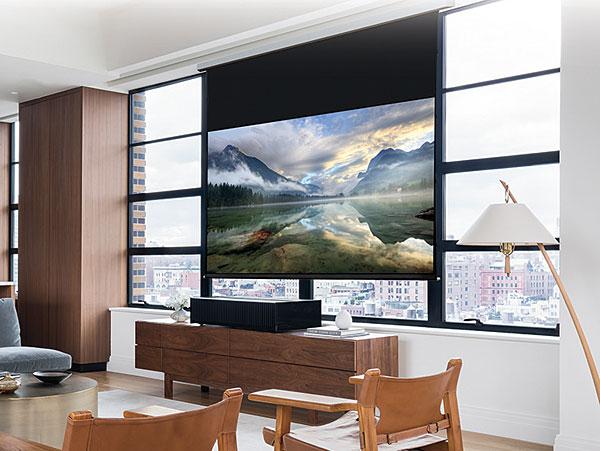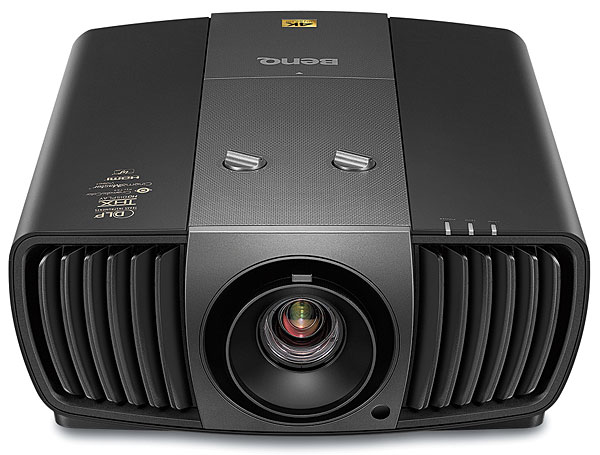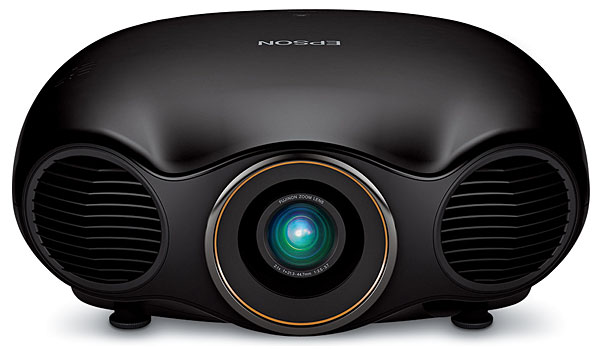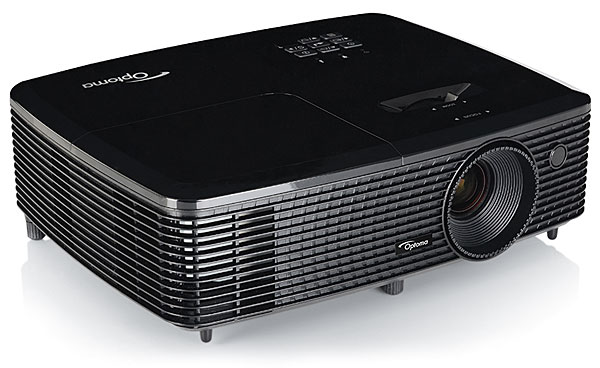You are going to own your projection screen a LOT longer than you will own your projector, and the screen has the benefit of NOT going obsolete! Everyone has a budget...stretch yours by investing in a GOOD screen, skimp on the projector if you must, but you will be FAR better off in the long run!
Projection's Reinvention

You might think that this trend toward bigger, better TVs for less money would spell doom for projectors, but think again. Not only is 4K alive and well in Projector Land, with all the attendant bells and whistles, but projection’s chief selling point over regular TV—an even larger picture for less money—has gotten a steroidal-like boost with the advent of ambient-light-rejecting (ALR) screens that allow for viewing in rooms where a flat-panel TV had been the only viable option. Meanwhile, an enthusiast who has always dreamed of a dedicated projection theater will find that there has never been a better time to get into the game. Good-quality 1080p home theater projectors have gotten dirt cheap—less than $1,000—and a respectable 100-inch matching screen for dark-room use can be had for about $200.
Of course, all of this recent change in both technology and market con-ditions means you’ll need to be a well-informed buyer. So let’s go.
Is Projection Right for You?
The answer to that question depends first and foremost on how you regard image size and quality, secondarily on the room where you plan to do your viewing, and finally on your budget.
Let’s take them one at a time, starting with screen size. Despite the trend toward larger flat-panel TVs at dropping prices, sets above the 75-inch-diagonal mark still demand a significant premium. And panels near or above 100 inches are toys for the one-percenters. But anyone who owns a projector can testify that you can’t beat the impact and engagement. There’s simply nothing you can have at home that draws you into the story more than sitting perhaps 15 feet from a 100-inch screen that fills most of your peripheral vision, preferably while you’re also in the sweet spot of a high-performance multichannel surround sound system. Whether we’re talking about a movie, the big game, a concert video, or a prime-time awards show like the Oscars, a projection system will make it a special event every time you sit down.
Assuming you’ve bought into that concept and have accepted the relative complexity of installing a projector and screen, you’ve got more options today than in the past. The classic dedicated dark-room home theater remains the goal for most A/V enthusiasts and serious movie buffs. It is, by definition, an isolated palace of escape and a place that allows for full optimization of both picture and sound. In this environment, the ability to fully control all ambient light is essential to achiev-ing the brightest image and best black levels and contrast from any projector. Even modest amounts of light filtering onto a conventional projection screen will noticeably wash out the image.

That said, this doesn’t mean you have to build a whole new room in your house (though doing so would also afford you the opportunity to acoustically isolate the theater from the rest of the home). Your den or family room where you already watch TV today can be transformed into a projection theater with the pulling of shades and the push of a button that drops a retractable screen down in front of your everyday flat-panel set. But there’s an assumption that you can and will control the extraneous light when you want to use your projector, even during daytime hours. And that you won’t be flipping on the projector to keep an eye on the news while you’re preparing dinner, the way you might with a conventional TV.
On the other hand, if you’re craving that large projection-sized screen but want a hybrid system that’ll function in either the dark or modestly bright ambient light, that’s where ALR screens come in. Sound & Vision has been reporting for years on so-called “high-gain” or gray screens intended to boost contrast in modest lighting or with darker source material. But their performance was marginal at best. Today’s ALR screens are another breed entirely, and they employ some sophisticated designs to more directly eject light coming from overhead or the sides of the screen while reflecting light from the projector back to the viewer. Combined with a projector offering suitable light output, some of these screens can produce a remarkably high-contrast image, even in a lit room, something impossible just a few years ago.
Not surprisingly, late-generation ALR screens are transforming the projection market and opening opportunities for the big-screen projection experience in multi-use spaces around the house, not just in addition to a flat panel but even as an alternative. The trade-offs? One is cost: The better examples of the breed can easily run $3,000 to $5,000 or more for a 100-inch-diagonal, 16:9 version. And although the image might look better than you’d expect when the lights are on, the nature of ALR screens is that they may produce a pearly or sparkly quality to the image surface that could be more noticeable when the lights are off. So if it’s paramount for you to get a smooth, film-like picture in a dark room, a conventional matte-white screen is still the best option.

You can see now how budget comes into play. If you’ve got a conventional home theater in mind where you can control light and handle the installation yourself, you can easily put together a fairly respectable projection system today with a 1080p projector and a screen that, together, start at around $1,000 or less. On the other hand, if you’re considering a lifestyle application that requires a high-tech ALR screen and a brighter projector, you might be looking at perhaps five times that starting budget.
Resolution Revolution
We’ve been pounding away in these pages on the benefits of Ultra HD. It started with the offering of 3840 x 2160 pixel resolution, which provides approximately 8 million pixels of detail versus the 2 million or so for what we now call 1080p or “Full HD” resolution. That spec for Ultra HD comes close to the 4096 x 2160 pixel count for true digital cinema 4K—hence, the common use of both terms in describing UHD displays. (So, despite what they told us, I guess “Full HD” was really only one-quarter full, eh?)
It turns out that UHD’s higher pixel count is a far more useful feature in projectors than it is in flat-panel TVs, where the benefits of that extra detail can be lost with displays of 75 inches or smaller unless you sit uncommonly close to the screen. On the other hand, those additional pixels are just what the video doctor ordered for large projection screens, where they can provide noticeably improved smoothing of diagonal and circular edges on objects and finer detail throughout the picture.

The more recently introduced features of wide color gamut (WCG) and high dynamic range (HDR) encoding for UHD content are even more desirable perks, especially for flat panels, but the news here for projector fans is mixed. Both 4K and 4K-compatible 1080p projectors (more on that shortly) are coming to market now, and while the additional color range of WCG is a shared benefit of these display types, the noticeably brighter highlights and deeper blacks of HDR just don’t come across with the same impact as they do on traditional TVs. Bright-ness has always been a challenge for projectors casting a large image, which explains why the digital projector at your local cinema is a monster that dwarfs any consumer product. But the ability to hit the high peak-brightness levels on small isolated portions of a projected image to provide the same level of enhanced viewing you get with HDR on a top-notch direct-view display has, for now anyway, not been demonstrated in any affordable consumer projector. This doesn’t mean that there isn’t noticeable extra punch visible when these projectors are fed HDR content, just that the experience still falls short of the more visceral effects possible with today’s best flat panels. That shouldn’t be enough to steer you away from the quite dramatic engagement you’ll have with an enormous projection screen, but it’s something to keep in mind.
Given the benefits of 4K projection with scaled-up 1080p material and emerging native 4K content delivered by the Ultra HD Blu-ray format and 4K video streams, you’ve got good reason to lean toward a 4K projec-tor. But here again, cost can be a deterrent. Native 4K consumer projectors are still scarce. Until recently, Sony was alone in this market, delivering a range of models starting at $10,000 and going up to $60,000. JVC recently joined them with a $35,000 model (see review on page 34 of this issue), and BenQ now has an $8,000 one.
- Log in or register to post comments


Had a fairly high end JVC D-ILA for many years and it looked sensational on a 120" Stewart Filmscreen. The problem now is you can't approach the picture quality of a new 4K TV for anywhere near the price.

Yes, TVs are getting bigger and better, but it seems like the industry has simply given up on what was admittedly a niche market, but nonetheless still one with quite passionate devotees who keep buying the product, i.e., 3D movies. Seems that the two big boys, SONY and LG, have stopped offering 3D capable TVs. 4K is all the rage now and so it they have fully abandoned 3D capable sets as of 2017. BUT, if you are a 3D fan like me and quite a number of my friends, we are in luck because the projector manufacturers are still committed to including 3D capability with the higher-end projectors. And if you are enthusiastic enough to be thinking of recreate that authentic cinema experience in your home by considering a video projector as opposed to TV, then the good news is, you will still be able to easily find quite a number of projectors still sporting 3rd dimension capability (you can't get more "movie theatre equivalency" than a big movie screen in your Home Theatre, which relatively speaking is probably bigger than what you see in many a multiplex), but then imagine adding 3D to that wall-to-wall living room screen! Regal, eat your heart out.
Unless something changes in the market place, seems like video projectors will be the only devices capable of presenting 3D content in the future to the home theatre aficionados.
And as far as projection screens...jnemesh has it exactly right -- your screen will most likely outlive your projector, so it's not the place where you want to try to save a buck. I would even go further and say, if you are committed to the movie theatre experience, I would suggest you seriously consider getting an acoustic-transparent screen. You really want to be able to place your speakers BEHIND the screen and this type of screen material will allow you to do just that; TVs, no matter how big, simply don't cut the mustard in this regard. Instead, what TVs tend to do is to force you to wind up using these puny little girly "sound bars" for the center channel -- the channel, BTW, from where the all-important dialog emanates. This invariably causes, the-music-is-so-loud-that-we-can't-hear-what-they-are-saying, syndrome. I can't tell you how often I hear that complaint -- then go check it out and they've got massive left and right channel speakers and not much more than a soundbar with not much more than cellphone-sized speakers in it. I am exaggerating of course, you the point is still valid.
Anyone who has worked professionally with cinema sound design and installation will tell you that the front three speaker channels and speaker systems are ALWAYS IDENTICAL both physically and electrically. That uniformity is essential for the system to produce a stereo soundfield that is cohesive and uniform across the entire screen and will produce sound as close as possible to what the cinema sound mixer heard in the mixing room.
I would also add, not being able to SEE the speaker boxes allows a very interesting psychological thing to happen with the way we perceive audio direction. If you can SEE the speakers, your brain keeps telling you that the sound is originating from that location (which of course it is); hide that visual cue, put the speakers being the screen, and all of a sudden, the space opens up and the sound is much less locked to those points - Left, Center, Right - than when you could see the speaker position.
When I had an Advent VideoBeam in the early 70s (long before there was such a thing as "home theatre,") the screen was fiberglass and speakers needed to be located on either side of it. I felt that the "localization effect" was powerful enough to impair the illusion, so we framed the screen with black chinese silk from the screen edge out to the wall, hiding the speakers; chinese silk is a fabric that was essentially acoustically transparent. It certainly made big difference in helping maintain the illusion that the sound was coming from all points across the entire screen.
Best to luck to everyone attempting to create their own bit of movie magic in their own place.

Designed to support foster parents or caregivers who are taking care of children who are not their biological children https://sassacheck.org/




















































